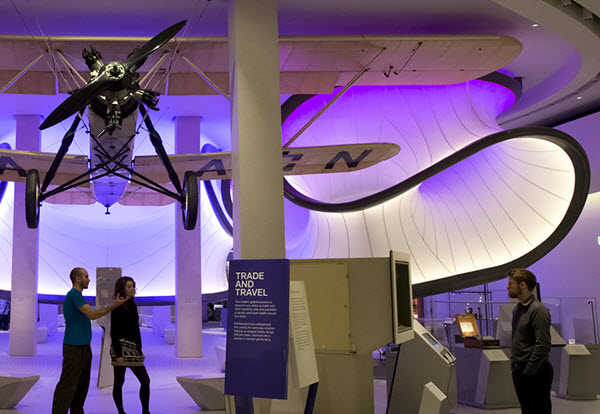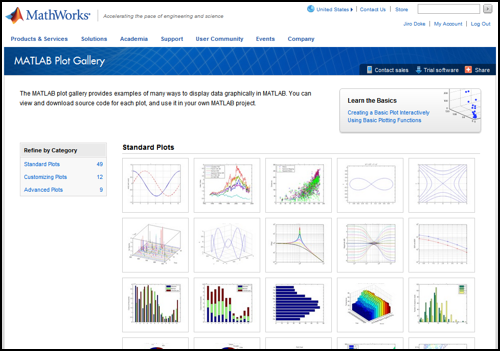MATLAB at the Science Museum
Here is a place I want to visit.

Image credit: Jody Kingzett
It’s the new mathematics gallery (known as Mathematics: The Winton Gallery) at the Science Museum in London. See that Handley Page biplane floating in the middle of the room? Everything in the gallery is modeled and placed according to the simulated airflow around that plane. Isn’t that cool? Check out this video to see what I mean.
I’m happy to report that MathWorks is a major sponsor of this exhibit, and I’m even happier to make space here for Dr. David Rooney to tell you about the gallery. Dr. Rooney is ideally positioned to do so because he is in fact the Keeper of Technologies and Engineering at the Science Museum, and lead curator of the gallery. Take it away, Dr. Rooney…
Mathematics: The Winton Gallery
by Dr. David Rooney
In December 2016, the Science Museum opened its bold new permanent exhibition, Mathematics: The Winton Gallery. Designed by Zaha Hadid Architects and occupying a 900 square metre space at the heart of the Museum, this new gallery showcases ways in which mathematical practice has underpinned everything we care about – from life and death to war and peace, money, trade, beauty and our attempts to control nature’s most elemental forces.
Visitors are faced with an astonishingly diverse array of historical artefacts. Some, such as the 1929 experimental biplane suspended at the heart of the room, seem an unusual choice for inclusion in a mathematics gallery. Discovering the mathematical story behind such exhibits offers new insights into the ubiquity of mathematics in today’s world. But other items on show immediately reveal their mathematical significance.
Taking pride of place in the gallery is one of the most significant objects in the history of computing: the trial assembly of Charles Babbage’s analytical engine, a general-purpose Victorian computing machine that would, if finished, have been the size of a small railway locomotive. Alongside it sits a copy of MATLAB 1.3, dating from 1985. Together, the two artefacts tell a remarkable story of the ways computing technologies have changed the world over the last 175 years – and continue to do so today.

Trial portion of Charles Babbage’s analytical engine, 1834–71
Image credit: Science Museum, London

MATLAB disk and manual, 1985
Image credit: Science Museum, London
All computers, at their heart, are very fast calculators. They perform simple operations on the numerical digits ‘one’ and ‘zero’ very quickly and in huge quantities. But fast calculators, whilst important, would not have changed the world. A crucial intellectual concept underpinned the analytical engine. The power of modern computers rests on the concept that numbers can represent other things – in fact, anything we choose.
This conceptual leap, that calculators gain enormous power if the numbers they manipulate are symbolic of other things, was made in the nineteenth century by Ada Lovelace. In 1843, she published an account articulating the analytical engine’s possibilities as a general-purpose computing device. In her description, she explained that the engine could do more than manipulate numbers as quantities. It could become a machine where numbers represented abstract items such as symbols or musical notes.
Lovelace’s insight came to mean that computing machines could in theory be programmed to model pretty much anything we wish – including those which are difficult to realise in reality. This is often the realm of pure mathematicians, whose work can be as much akin to philosophy as to science. Such mathematicians imagine abstract mathematical worlds, and increasingly use powerful computers to handle and test the models they think up. In doing so, they are searching for patterns and structure that might help us understand the universe.
This is where MATLAB comes in. Today, mathematicians have access not only to incredibly powerful computing technologies, but also to software that enables the most abstract ideas as well as real-world problems to be modelled and manipulated. The original digital computers required great skill and expertise to programme. Nowadays, packages such as MATLAB, first released in the 1980s, let mathematical practitioners in all walks of life grapple with the toughest mathematical ideas.
Mathematics: The Winton Gallery opened on 8 December 2016 and is free to enter. For further information visit sciencemuseum.org.uk/mathematics.









Comments
To leave a comment, please click here to sign in to your MathWorks Account or create a new one.